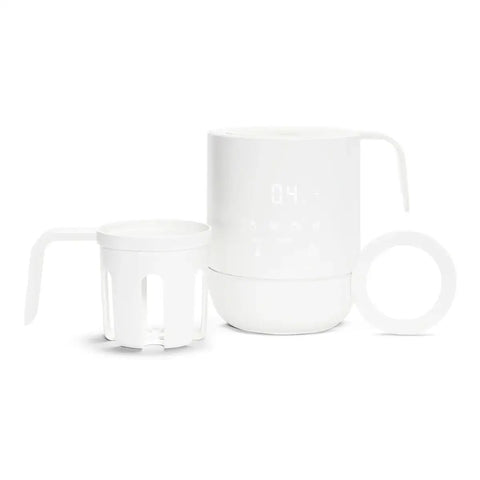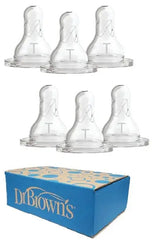When to Start
Parents often ask "when is the best time to introduce a bottle?" There is not a perfect time, but lactation consultants usually recommend waiting until the breast milk supply is established and breastfeeding is going well. Offering a bottle somewhere between 2-4 weeks is a good time frame. Occasionally waiting too long (after 6 weeks) can result in a baby who may strongly refuse the bottle.
How Often
Offering a bottle 3-4 times a week and no more then once a day should keep baby familiar with the artificial nipple while maintaining a strong breastfeeding relationship. If your baby starts to prefer the bottle over the breast, simply offer the bottle less frequently or stop bottle feeding all together until breastfeeding is again going well. Remember, especially during the early months, if the baby receives a bottle, mom must pump to protect her milk supply. Although a full night's sleep might sound tempting, a mother must not go too long without expressing milk from her breasts or her supply will drop.
Early Supplementation
If you need to give your baby a bottle before 2-4 weeks for medical reasons, contact a lactation consultant for advice on how to build and protect your milk supply while maintaining a breastfeeding relationship.
We currently offer professional Lactation Consultations. Our team of International Board Certified Lactation Consultants offer one-on-one, gentle, virtual support for all breastfeeding problems.
The Approach
The baby is an active participant in the breastfeeding relationship. He must root, seek the breast, and open wide to latch. To support breastfeeding, it is important to replicate this behavior with a bottle.
- Select a slow flow nipple that will require the baby to use some effort to get the milk from the bottle.
- Place the baby in an almost upright position. Hold the bottle in a horizontal position just filling the nipple with breastmilk. By holding the bottle horizontally, gravity does not play a role in the milk flow.
- Encourage your baby to open wide and seek the bottle by brushing his lips with the nipple. When the baby opens his mouth wide like a yawn, place the entire nipple into the baby's mouth so that his lips rest gently on the nipple base. Do not allow him to take only the tip of the nipple into his mouth. (may result in sore nipples for mom when nursing)
- When the baby starts sucking, tip the bottle up just enough so there is no air in the nipple and milk covers the nipple hole. Allow the baby to pace the feed comfortably. Watch the baby's cues for a comfortable versus a stressful feed. If she is gulping milk with wide-open eyes and splayed fingers, the milk may be flowing too quickly. Lower the end of the bottle while it is still in the baby's mouth to slow the milk flow. The baby should be using jaw-dropping sucks, similar to breastfeeding and should not have milk leaking from his lips. Stress cues include: worried brow, gulping, gasping, panting, pushing bottle, or looking away.
- A bottle-feeding should take about 15-20 minutes. If the baby finishes the bottle in 5-10 minutes, the flow is likely too fast. If it takes your baby 30-45 minutes to take a bottle, the flow is too slow. Consider changing the bottle and nipple to meet your baby's needs. One bottle to consider are the Dr. Browns with a Preemie nipple. There is no one bottle that is the best ... the best bottle for your baby is the one that does not leak around his lips and he can eat slowly and comfortably.
- Do not coax your baby to finish the bottle. Watch your baby's cues (slower suckles, releasing nipple from her mouth, falling asleep) for indications that he has finished his meal.
Bottle Refusal
Occasionally a breastfed baby will begin to refuse an artificial nipple for feeding. The following are some suggestions that may help when offering a bottle to a resisting baby. Encouraging your breastfed baby to accept a bottle is a process that may require both practice and patience for several weeks.
Who should offer the bottle?
- Some babies will refuse the bottle if they know mom is available. Have dad or another caregiver offer the bottle. Mother may need to step out of the room or leave the house during the bottle-feeding.
- Since the baby associates mom with feeding, she may be the only one who can successfully offer the bottle. If she is successful in bottle-feeding, try switching mid feed so dad and mom can offer the bottle together.
Try different positions:
- Hold the baby more upright in a semi-reclining position.
- Try holding and cuddling the baby similar to breastfeeding.
- Hold the baby so that their back is leaning on Dad's chest and baby is looking outward.
- Try placing the baby in a bouncy seat or stroller when offering the bottle.
Never Prop the Bottle!
Try some distraction:
- Use movement. Walk around the house looking at different items while feeding.
- Take the baby outside to look at bushes, birds, and clouds.
- Offer the breast and, when baby becomes sleepy, remove your nipple and slip in the bottle nipple.
- Offer a pacifier. Once baby is calm, remove the pacifier and replace with the bottle.
- Offer the breast and once you have had your first let down, switch to the bottle.
- Try singing and movement while feeding the bottle. Some moms sing a song when breastfeeding. Try using the same song when offering the bottle.
- Place the baby under or near a mobile while trying the bottle
- Have mom hold a blanket or small "lovey/lovie" when nursing, and then have dad hold the same item when giving a bottle
More Helpful Tips
- Some moms find that their refrigerated or frozen milk tastes soapy. This is due to an excess of the enzyme lipase. Many babies do not mind the taste, but some do and will start to refuse the bottle. Scalding your milk before cooling can inactivate the enzyme. Contact us if you have more questions.
Santa Monica: (310) 998-1981 - Offer the bottle once or twice a day during a time when everyone is relaxed and happy. Practice for 5-10 minutes doing your best to keep it a "happy time." A daily practice can help your baby adjust to the bottle over time.
- Try letting the baby play with the bottle, mouth the nipple without having a feeding agenda.
- Offer small amounts. Even a few sips are a step in the right direction. If they don't finish the bottle, you won't have wasted much of your precious milk.
- If baby becomes overwhelmed with bottle-feeding attempts. Comfort and console them. Wait about 10 minutes before offering the breast.
- Warm the bottle nipple or dip it in warm breastmilk.
- Use fresh (not frozen) breastmilk. Some babies will prefer the milk warm and others may like it cold.
- Try a slow flow nipple. However, if mom has a fast flow, baby may prefer a medium flow nipple.
- Your baby should be able to take a 3-4 oz. bottle in about 15-20 minutes. If they finish too quickly they may not feel satiated and look for more milk that they may not really need. If they are gulping the bottle, pace the feeding and interrupt the feeding for burps.
- If the bottle is too slow, baby may get frustrated with the bottle overall. Find a bottle and nipple that works for your baby. Many mothers have reported success with bottles with a soft "hilt" such as Munchkin Latch.
Important Reminders:
- Keep a positive attitude and do not allow bottle-feeding battles to result in a frustrated baby and tearful parents.
- Offer the bottle when baby is slightly hungry. Waiting until the baby is "really hungry" does not work.
- Do not withhold food for long periods of time. Parents are often told that if a baby is hungry enough she will eventually break down and take the bottle. This is usually not true. Your baby is not just being stubborn. They just don't know what to do with the bottle. Withholding the breast can cause great stress to both the baby and the parents (and could lead to dehydration). Give your baby time to learn the new skill; patience, practice and persistence usually pay off.
- Don't let dad always be the bad guy. Find other nurturing people to help with bottle-feeding. Even mom can try and often has the most success.
- A successful bottle-feed does not have to be all or nothing. Your baby may take an ounce or two with the bottle then finish at the breast. This is a good start!
Essential Breastfeeding Support and Baby Care Items
The Pump Station & Nurtury® has decades of experience providing new families with outstanding educational, breastfeeding and baby care support, including products and classes which can make all the difference to you and your baby. To see a list of some of the essential products that our Lactation Professionals have recommended, click Essential Breastfeeding and Baby Care Products.
YOU MAY BE INTERESTED IN:
Plugged or Clogged Milk Ducts and Mastitis: The Latest Treatment Tips
Breastfeeding and Thrush: We Answer Your Questions
Why Was Crawling Eliminated from CDC Milestones?
Our Moms Love Their Mommy & Me Group: Here's Why
And Other Breastfeeding and Baby Care Help Topics
Copyright© 2020 by The Pump Station & Nurtury®. All rights reserved. No part of this handout may be reproduced or transmitted in any form or by any means, electronic or mechanical, including photocopy, without permission in writing from The Pump Station & Nurtury®. This article has not been prepared by a physician, is not intended as medical advice, and is not a substitute for regular medical care. Consult with a physician if medical symptoms or problems occur.
Revised 11/2024


























